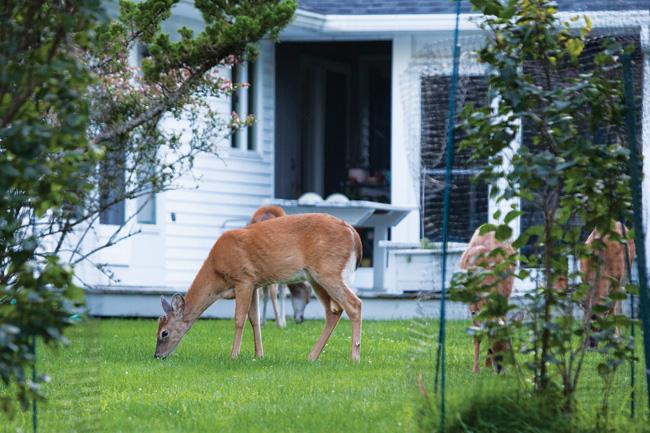Should Southold Town hire a part-time wildlife manager?

Deer management and environmental advocates say they have the facts to show the North Fork’s deer population is a “health emergency,” causing more than $1 million in damage due to car accidents and sickening hundreds of residents thanks to tick-borne illnesses.
The group’s challenge? Getting their neighbors on board with a plan to thin the herd.
A group of advocates asked the Southold Town Board at its meeting Tuesday morning to hire a part-time “wildlife management professional” to manage the deer population and — most importantly — convince private land owners to allow bow hunters on their property.
Last year’s federally assisted deer cull was unsuccessful in part because many residents refused to allow trained sharpshooters on their properties and local hunters felt the cull was “infringing on their sport,” said John Severini, a member of the North Fork Deer Management Alliance.
“The problem with the cull was it was poorly communicated,” he said.
He said the growing deer population has become large enough to damage the ecosystem and spread tick-borne diseases like Lyme disease. He cited figures from the Southold Town Police Department claiming more than 25 percent of all car crashes in 2014 involved deer.
The deer population has also been rising, despite cull efforts, he said.
“The number is not going in the right direction,” he said.
Dr. John Rasweiler, a member of the town’s deer management committee, Suffolk County’s tick control advisory committee and an animal reproduction expert who specializes in wildlife management, said the state’s response to the crisis has been “totally inadequate.”
“What are we, as a society, doing to protect our citizens from tick-borne diseases?” he asked. “Really, very little that is meaningful.”
Dr. Rasweiler said hunters are now allowed on town lands, but noted deer have already extensively grazed that area, making it harder to find them.
“It’s critical for us to move beyond hunting just those lands,” he said. “Somehow we have to open up private lands that have a lot of deer.”
Mr. Severini said a part-time employee could act a liaison from the town, speaking to community groups and concerned citizens about the need for a cull.
He added that recruiting the town’s local hunters could cull more deer, but those hunters would need training in deer management and best practices. A town employee could focus on that as well.
But while the board said they understood the risks of the deer population and agreed with the need for management, Town Supervisor Scott Russell said it was up to civic groups to spread the word.
“Access to areas where the deer are is the problem,” Mr. Russell said. “That’s the hump we have to go over … There’s only so much we [the town] can do.”
But Mr. Severini said the volunteers were already working hard to convince others and needed the authority of a town figure to help their cause.
“We’re willing to do our part … but I will say its unfair to ask [that] of an all volunteer army,” Mr. Severini said.
Town Board members said the advocates would need to have a clearer plan to explain to residents.
“You have to get people on board to do it,” said board member Robert Ghosio. He said more outreach was needed; the town attempted to spread the word through ads and op-eds, but didn’t hear back from any residents.
But the Town Board didn’t rule out a new hire. Mr. Russell recommended the town’s deer management committee discuss the need for a part-time worker, saying there was “plenty of time” left in the budget cycle to fit in a new hire for next year if it was deemed important enough.
Photo Caption: A group of white-tailed deer grazing in Southold. (Credit: Katharine Schroeder)






